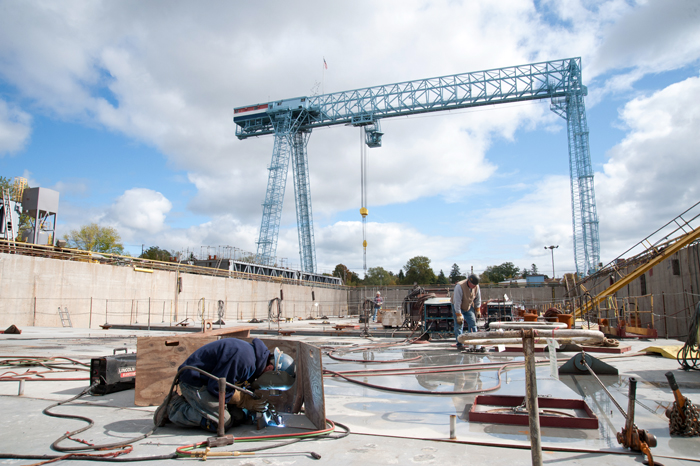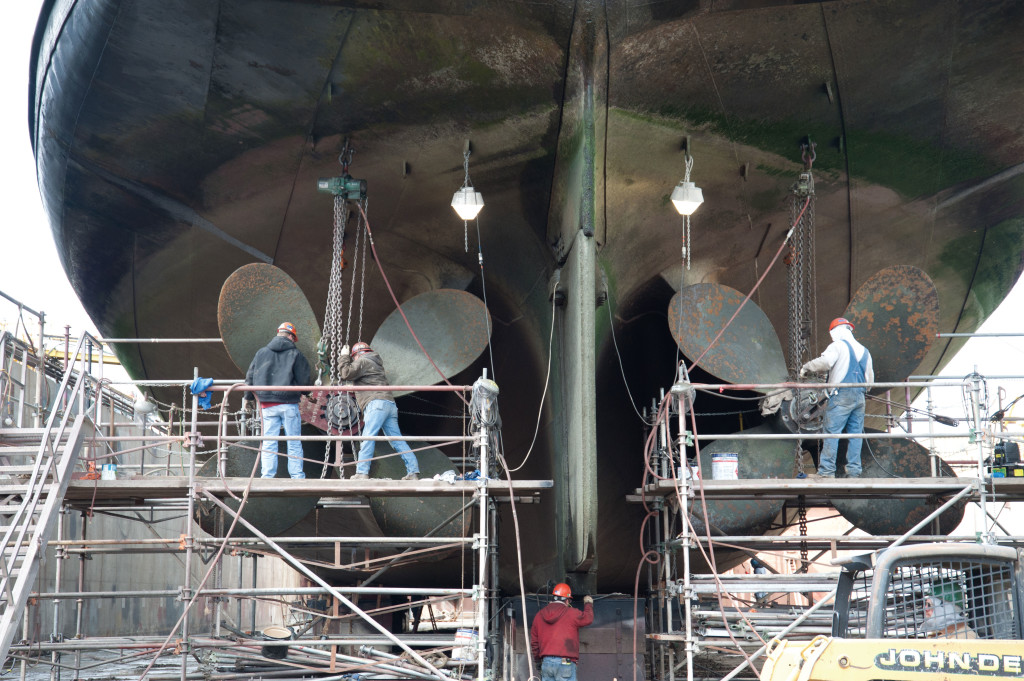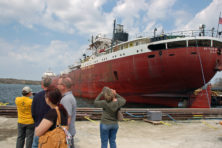Riding the Waves of the Sturgeon Bay Shipbuilding Industry
- Share
- Tweet
- Pin
- Share

It’s 8:30 in the morning on the 4th of September, and the stools at the Red Room tavern on Sturgeon Bay’s 3rd Avenue are mostly empty, save for three retired gentlemen sipping on coffee and Baumeister root beer. The rest are occupied only by the morning sun slipping in through the windows.
There was a time when the place would be packed with workers fresh off the third shift at the shipyards, enjoying the morning happy hour.
“It used to be like a Friday night in here in the morning,” says 30-year-old bartender Nick Hoffman as he leans behind the bar, the third generation of his family to lean there. “Used to be we’d get the third-shifters, but there’s not too many of them anymore. I don’t even know if they work a third shift now.”

The Red Room used to be crowded with shipyard workers first thing in the morning when the third shift ended. Today, those crowds are rare, with tourist and service industry workers more common. Photo by Len Villano.
Most of the time, Door County seems insulated from the highs and lows of the larger world. The financial crisis that shocked the world in the fall of 2008 didn’t initially hit hard here. There were no gleaming towers full of suits losing jobs, no corporate headquarters being emptied.
But the ripples that originated with a splash on Wall Street eventually made it through the narrow Sturgeon Bay Ship Canal. When customers couldn’t secure the credit to purchase the big ships and yachts that Sturgeon Bay is famous for and the world economy slowed to a crawl, the ship traffic on the Great Lakes slowed by a third. Ships that were once rushed into service as soon as the ice would allow were kept in port all summer because the demand for iron ore, coal, and stone plummeted.
That meant they weren’t getting beat up on the lake, collecting the wear and tear for the workers of Bay Shipbuilding Company (known simply as Bay Ship to locals) to fix over the winter. In August, anticipating the likelihood of a slow repair season, Bay Ship announced that it might have to lay off as many as 405 workers if work didn’t come through.
The uncertainty left Hoffman worried for the city, not only because of the jobs, but because those jobs affect everything in the city. “The next couple years are going to be interesting around here,” Hoffman says. “Tough on a lot of people. It’s gonna affect everything.”
Bay Ship is the county’s largest employer, a title held by one of the city’s major shipbuilders for most of the past 100 years. Palmer Johnson yacht builders, currently, is fifth.
At its peacetime peak, Bay Ship employed about 2,000 workers. In the spring of 2008 the number was 675, but it’s always in flux. In the winter months, when the Great Lakes “winter fleet” fills the docks with as many as 18 lakers in for repairs, the workforce swells to almost 900.
Pat O’Hern, Bay Ship’s vice president and general manager, is not a suit. He wears a patterned shirt, no tie or sport coat. His office is not elaborate, his desk utilitarian, the chairs of the basic waiting room variety. It’s housed in the same steel shed construction as the rest of the yard’s buildings, and on the wet spring day I met with him in his office, the sound of clanging steel and the buzz of welding torches rang past the front doors.

The Gantry Crane that towers over the Bay Shipbuilding yard is one of Sturgeon Bay’s most recognizable structures.
“Nobody’s going to escape this downturn, us included,” he said. On that day, O’hern was weary, and the stress on him was palpable. Bay Ship does not operate in a vacuum. When business is good, it’s good for the whole city and the whole county. When business turns sour, everyone feels it in some way – toys not bought, tax revenue not collected, restaurant tables left empty. Carrying such a large portion of the fortunes of a city on your company’s shoulders is a heavy burden to bear.
“There are a lot of sleepless nights,” O’hern said. He paused and tapped his pencil lightly often throughout our conversation. He wore the look of a man with a lot on his mind, and spoke with measured optimism. Bay Ship weathered difficult economies before, most notably in the late 1980s, when massive layoffs shook the county. He said that was the toughest time of his career.
“We knew there was no shipbuilding that was coming in the near term,” he remembered.
Peterson Builders Inc., another of the city’s major shipbuilders, was still operating at the time and faced the same uncertainty. The company was founded by Fred J. Peterson in 1933 and thrived for decades as a family-run yard. Fred’s son Ellsworth said the yard was still employing 1,400 workers in the mid-1980s building minesweepers and rescue boats for the U.S. Navy, but when the cold war simmered, the government contracts stopped coming.
“Business dropped off rapidly,” Ellsworth said. “The military was only building aircraft carriers and submarines, and neither of those fit in the Great Lakes.”
In one moment, the shipbuilding business appears unsinkable, the next, it appears perilous. “In shipbuilding you live from one bid to the next,” Ellsworth said. “And you never know if you’re going to get the next one.”
When business slowed with the end of the military contracts, Ellsworth said they couldn’t simply scale back. “You get so big that you can’t sustain the operations when the contracts don’t come through,” he said.
In 1995, Peterson Builders closed its doors after 62 years of chasing contracts, ending a family boatbuilding tradition that dated back to 1907. Ellsworth said it was a difficult decision to make, “but there was no one left in the family to take it up.”
At the same time, Bay Ship was experiencing a resurgence. Yards all over the lakes were closing, but a small city on the Door Peninsula was regaining its strength. O’hern said the company survived on the backs of quality workers, a great reputation, and ownership committed to making it through the tough times. What little work that was available in the lean years went to Bay Ship, keeping it alive.
“Our ability to compete in a global market is a direct function of the quality of our local employees,” O’Hern said. “We just have a collection of people who work hard and recognize that the boss is the customer. Our average employee has been here 30 to 35 years. People here grow up building Great Lakes self-unloading vessels.”
Sam Perlman, Economic Development Manager for the Door County Economic Development Corporation (DCEDC), echoed O’Hern’s sentiment. “There are generations of craftsmen who have lived and worked in those yards, building the expertise and providing the dedication that keeps those jobs and those companies here,” Perlman said.

Shipbuilding defines Sturgeon Bay, and for decades, the industry employed hundreds of Northern Door farmers in the winter months. Photo by Dan Eggert.
From 1987 to 1995, Bay Ship didn’t build any ships, relying entirely on ship repair to support the business. But then the larger forces of the economy trickled into the yard, this time carrying a pleasant surprise.
After the Exxon Valdez oil spill off the coast of Alaska generated horrific images of wildlife suffering in black sludge in 1989, Congress enacted the Oil Pollution Act of 1990, mandating double-hull construction for all oil tankers operating in U.S. waters. This proved to be an unexpected boon to Bay Ship, as there was a sudden market for work building massive tankers, the size Peterson wasn’t equipped to build. Over the next 19 years, Bay Ship sold 21 double-hull oil tankers. In 1999, Mobil, the world’s largest corporation, bought its first double-hull tanker from Bay Ship. In all, Bay Ship has produced 29 hulls since 1995.
In 2004, the DCEDC partnered with the city, Bay Ship and Palmer Johnson Yachts to produce the Sturgeon Bay Shipbuilding Cluster Master Plan, addressing the future infrastructure needs of the city’s shipbuilding industry.
Soon after, new facilities rose just steps from the city’s historic Third Avenue, where visitors flock as happy cogs in Sturgeon Bay’s burgeoning new industry, tourism. When those tourists pull down Jefferson Street and into the historic district, shipbuilding’s omnipresence in the community is inescapable, for staring back at them is the giant new Palmer Johnson facility born in that cluster plan. It was part of more than $21.5 million in new buildings, equipment, and working capital in the city.
As guests stroll down the sidewalks, grabbing coffee or hauling shopping bags, they see the Sturgeon Bay Visitor Center logo, an anchor, in windows and on signs. Shops sell photos and paintings of ships and the winter fleet, and the restaurants bear names, like The Nautical and Café Launch, that nod to the lifeblood on the other end of the avenue.
On December 31, 2008, Fincantieri Marine Group bought Manitowoc Marine, Bay Ship’s parent company. The sale raised eyebrows, most notably because Fincantieri is an Italian company, but O’Hern is relieved the company was bought by another shipbuilder.
“I’d rather we be owned by a shipbuilder than an investment banker,” he said. “It’s encouraging that all they do is build and repair ships. They are replacing a training center and outfit module shop, and I’m confident they’re committed to Bay Ship in Sturgeon Bay for years to come.”
In 2009, Bay Ship continued to build. Its workforce finished refitting the Charles M. Beagly with two heavy-fuel diesel engines to give it another 20 years of shipping life. It delivered the last in a three-vessel contract with U.S. Shipping, a 156,000-barrel chemical barge on August 1st. In November, a 185,000-barrel oil barge capable of carrying 7.8 million gallons was delivered to K-Sea Transportation of East Brunswick, New Jersey.
It was that same optimism that fed the spirit of Fred J. Peterson when he brought his family back into the boat building business during the heart of the Great Depression. His father Martin Peterson was the first in the family to tackle the trade, opening Peterson Boat Works in 1907, when ramshackle boatyards were sprouting along the canal. Fred worked for his father, but in 1918, Peterson Boat Works burned, pushing Fred into the employ of Leathem Smith Dock Company for the next 15 years.
When he finally decided to put the family name back in business, Fred couldn’t have known that the glory days of Sturgeon Bay shipbuilding were right around the corner, when World War II mobilized the nation to supply American forces overseas.
At the height of the war, Sturgeon Bay’s yards were churning out a new ship every five days, an astounding pace. The city mobilized to meet the demand, creating a public transportation service, erecting a ship worker’s village, and adding infrastructure to handle the influx of nearly 7,000 new workers. The city’s population ballooned to 14,000 in 1944; nearly double its previous population and a level it has never approached since.
It was the exemplary production of Sturgeon Bay through the war years that solidified the reputation of the local shipyards and their workers. It created a foundation for decades of work, good jobs, and prosperity, all forged on the heels of the worst economic era the country has ever known.
As fall arrived in Door County in 2009, and prospects for a large winter fleet of repair work appeared bleak, I thought back to the spring conversation with O’Hern. Then, despite the bad economic news coming his way, he looked ahead to a turn-around, knowing Bay Ship would be there, and its expertise in demand – not unlike Fred Peterson when he dove into the business during the Great Depression. The lows have come before, O’Hern recognized, bringing with them, eventually, the highs again.
“I’m optimistic about being here for the long term,” he said, referring to Sturgeon Bay’s place in the world market. “This market will not stay bad forever.”
Sturgeon Bay’s breakfast counters, grocery stores, and those empty bar stools on the other end of Third Avenue are counting on O’Hern being right.




